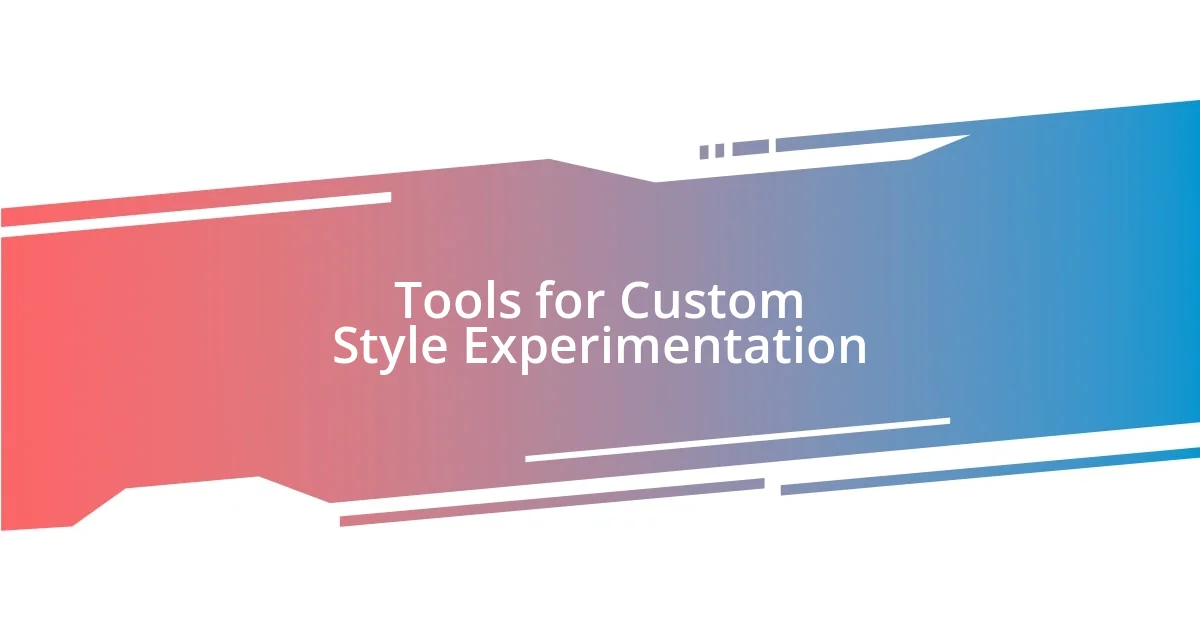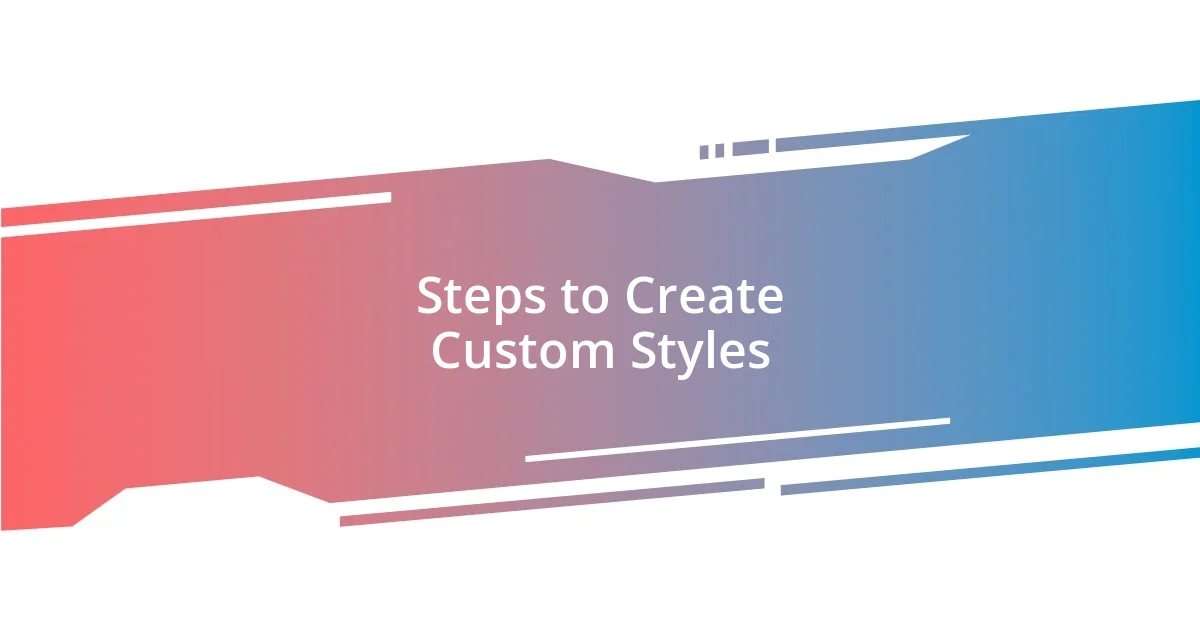Key takeaways:
- Experimenting with custom styles fosters personal expression and enhances the connection between the creator and their work.
- Collaboration and feedback are crucial in refining designs, leading to deeper insights and improved results.
- Adaptability and iteration are essential lessons in the design process, as they allow for growth and evolution in style choices.

Introduction to Custom Styles
Custom styles aren’t just a trend; they’re a powerful tool for expressing individuality in design. I remember the excitement I felt when I first stumbled upon the ability to customize my digital workspace. It was as if a whole new world opened up, allowing me to create an environment that truly reflected my personality.
When I began experimenting with custom styles, I found myself asking, “How can I make this space feel more ‘me’?” Each tweak, from color schemes to fonts, brought me an unexpected sense of ownership. It was exhilarating to see the transformation unfold and to connect on a personal level with my creations.
Diving into custom styles also felt incredibly liberating, as I could test the waters of creativity without any boundaries. I’ll never forget the moment I discovered a combination of colors that resonated with my mood perfectly—it was like finding a hidden gem that made everything click. This journey taught me that custom styles aren’t just about aesthetics; they’re about crafting a visual identity that speaks to who we are.

Importance of Custom Styles
When I think about the importance of custom styles, I often reflect on a moment when I chose a vibrant color palette for my project. It wasn’t just about visually standing out; it was about igniting passionate feelings and sparking creativity in everyone who encountered it. I quickly realized that custom styles have the power to convey emotions and set the tone for an entire experience.
Consider how custom styles can elevate your design:
- Express Your Unique Voice: They allow you to showcase your personality, leading to stronger connections with your audience.
- Enhance User Experience: A thoughtful design can guide users intuitively, making their navigation feel seamless and enjoyable.
- Build Brand Recognition: Consistent custom styles make your brand memorable, helping it to stand out in a crowded market.
Through experimentation, I’ve learned that the right combination of elements can foster not just engagement but also a deeper understanding of the emotions tied to design. Custom styles are a way to share a piece of ourselves with the world.

Tools for Custom Style Experimentation
When it comes to tools for custom style experimentation, there’s a wide array that I’ve personally found invaluable. I remember the first time I tried out a CSS editor; the instant feedback I received as I adjusted margins and colors was simply electrifying. Suddenly, my ideas materialized right before my eyes, and through that process, I could experiment fearlessly, making bold decisions I hadn’t thought possible before.
Then there’s the potential of design software like Adobe XD or Figma. I vividly recall a late-night brainstorming session where I played around with layout designs. The intuitive interfaces allowed me to toggle between elements seamlessly, and the ability to prototype my work made me feel like an artist unveiling a masterpiece. These tools don’t just facilitate change—they inspire creativity and encourage unexpected outcomes.
Lastly, I should mention browser developer tools. Often overlooked, I find these tools perfect for quick style tweaks. It was during a collaborative project where I used these tools to show a colleague how easily we could implement user feedback in real time. Watching their face light up as they saw the changes—right then and there—was a reminder of how powerful experimenting can be.
| Tool | Key Feature |
|---|---|
| CSS Editors | Real-time visual feedback |
| Design Software (Adobe XD, Figma) | Prototyping and intuitive interfaces |
| Browser Developer Tools | Instant style tweaking for testing |

Steps to Create Custom Styles
Creating custom styles is an exciting journey that begins with defining your vision. I remember sitting at my desk, sketching out ideas for a website, and pouring my heart into capturing the essence of what I wanted to communicate. What if I told you that just mapping out a mood board with colors, textures, and themes can ignite that initial spark of creativity? It’s all about letting your imagination roam free before you dive into the technicalities.
Once you have a solid foundation, the next step involves experimenting with different design elements. Take it from me—playing around with typography can completely change the vibe of your project. I vividly recall switching fonts on a whim during a late-night session and realizing how the right typeface could evoke a sense of elegance or playfulness. Are there fonts that resonate with your audience? Finding that match can be pivotal in expressing your message.
Lastly, don’t shy away from seeking feedback throughout the process. I had a moment where I shared my custom styles with a trusted friend. Their perspective opened my eyes to aspects I hadn’t considered, like the impact of readability on user engagement. It was a gentle reminder that collaborating can lead to richer ideas. How do you feel about embracing others’ opinions? Engaging with peers can not only refine your style but also create a supportive design community that fosters growth.

Best Practices for Custom Styles
When building custom styles, consistency is key. I’ve often found that sticking to a cohesive color palette and typography creates a sense of harmony across my designs. For instance, while working on a branding project, I chose three main colors that resonated with the brand’s identity. Seeing those colors consistently applied made everything feel more unified and professional. How do you approach consistency in your own projects?
Another essential practice is to keep usability in mind. I remember an eye-opening moment while analyzing a website I designed. After receiving feedback about font size being too small, I realized that aesthetic choices shouldn’t overshadow user experience. Effective design is not only about looking good; it’s about being functional and accessible. Have you considered how your design choices impact usability?
Finally, I advocate for documenting your style experiments. I keep a design journal where I jot down insights, sketches, and iterations. One time, I stumbled upon a forgotten concept that I had previously abandoned. Revisiting that idea led me to create something innovative that I might have otherwise overlooked. This practice allows me to reflect on my evolution as a designer while sparking new ideas. Have you ever thought about how documenting your process could unveil fresh perspectives?

Sharing and Showcasing Custom Styles
Sharing custom styles can often feel like unveiling a piece of your soul to the world. I remember the rush of excitement when I first showcased my custom designs on social media. The responses were a mix of admiration and curiosity—people wanted to know how I arrived at each choice. Isn’t it fascinating how sharing a creative journey can connect us with others who share similar passions?
Collaborating with fellow designers also takes the experience to another level. I recently paired up with a friend who had a different design aesthetic. By exchanging ideas and showcasing our custom styles to each other, we discovered fresh perspectives that enriched our work. It’s incredible how a simple conversation can breathe new life into your designs. Have you ever collaborated on a creative project? If you haven’t, I strongly encourage you to give it a try—it’s rewarding in ways you might not anticipate.
Lastly, I find that creating a portfolio to showcase these custom styles is both fulfilling and strategic. When I compiled my designs into a visually appealing layout, it felt like crafting a narrative that spoke directly to anyone browsing through. This thoughtful presentation not only highlighted my growth as a designer but also sparked deeper discussions with potential clients. What story do your designs tell? Reflecting on this can elevate your work from mere aesthetics to meaningful connections in the design community.

Lessons Learned from My Experimentation
One key lesson I learned is the importance of adaptability. During my experimentation, I vividly recall a project where I initially committed to a bold, unconventional style. However, as I shared drafts with peers, I received feedback that highlighted the need for a more traditional approach for the target audience. It was a tough pill to swallow, but I ultimately realized that flexibility in design choices can lead to a more effective final product. Have you ever had to pivot your style for the sake of your audience?
Another enlightening moment came when I embraced the principle of iteration. I used to think that once I finalized a custom style, that was it. Then I discovered the power of revisiting designs over time. There were instances when I reflected on past styles and felt inspired to rework them with new techniques I had acquired. It’s amusing how a concept I once thought was perfect could benefit from fresh eyes. Isn’t it interesting how design evolves alongside our growth as creators?
I also learned to trust my instincts more. There was a time when I hesitated to make bold choices, fearing they wouldn’t resonate with others. However, when I decided to embrace my unique style, the response was overwhelmingly positive. It’s exhilarating to realize that authenticity in creativity often garners genuine appreciation. How do you find your voice amidst the noise of design trends? I believe the answer lies in being true to oneself.















